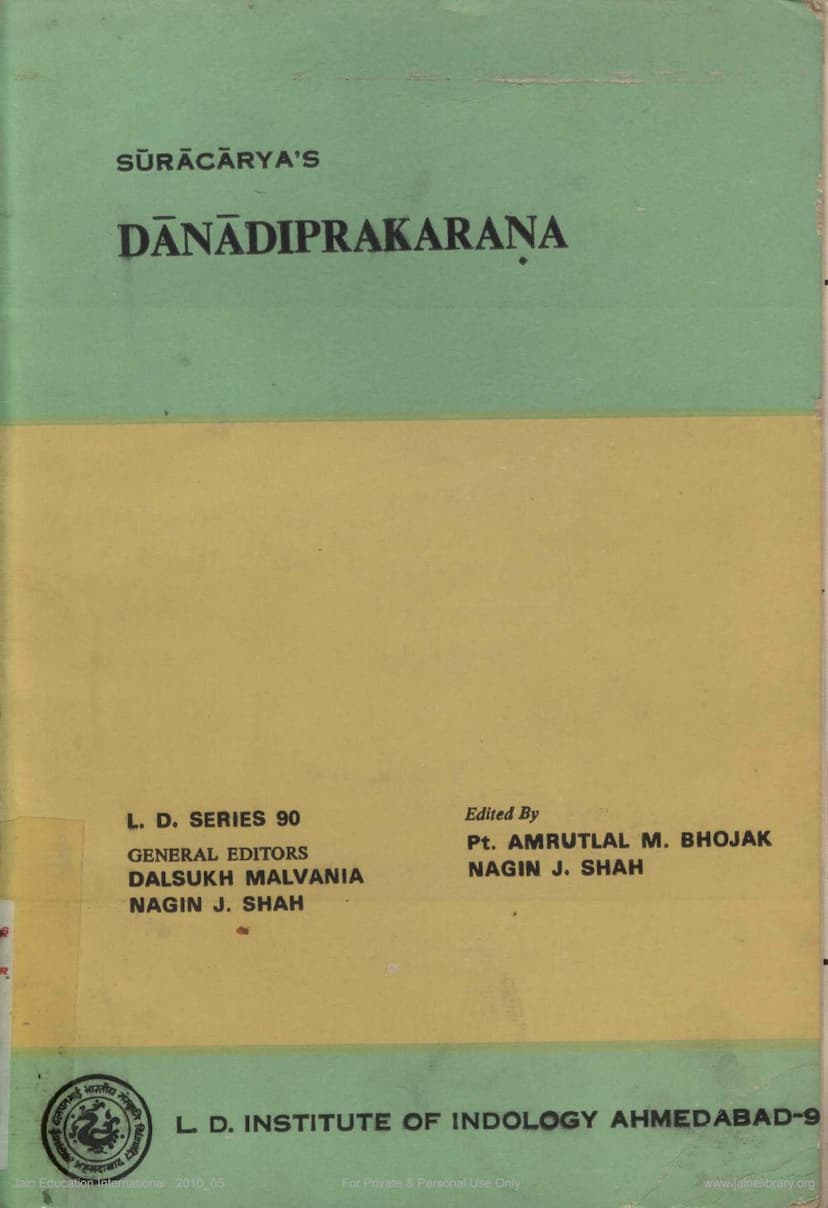Danadiprakarana
Added to library: September 1, 2025

Summary
Here's a comprehensive summary of Sūrācārya's Dānādiprakarana based on the provided text:
Book Title: Dānādiprakarana Author: Sūrācārya Editors: Pt. Amrutlal M. Bhojak, Nagin J. Shah Publisher: L. D. Institute of Indology, Ahmedabad Series: L. D. Series 90 Publication Date: January 1983
Overview:
Sūrācārya's Dānādiprakarana is a significant Jain text composed in Sanskrit, likely in the late 11th century V.S. (circa 1070-1090 CE). The work is divided into seven "avasaras" (sections) and contains a total of 537 verses in various meters. As the title suggests, the book primarily deals with various forms of dāna (charity or giving), particularly focusing on jñānadāna (giving of knowledge), abhayadāna (giving of fearlessness or protection), annadāna (giving of food), and dhanadāna (giving of wealth). The text also discusses the importance of constructing and protecting Jain temples, installing Jina images, and preserving manuscripts.
Key Themes and Content:
-
The Four Types of Dāna: The core of the work expounds upon the spiritual benefits and significance of different acts of giving:
- Jñānadāna (Giving of Knowledge): This is considered the highest form of charity. The text emphasizes that true knowledge, including understanding what to avoid (heya) and what to accept (upadeya), is essential for spiritual progress. Knowledge purifies the mind, speech, and body, leading to non-attachment. The author highlights the importance of the words of Jina, acquiring knowledge from a spiritual teacher, respecting the learned, and the pursuit of knowledge itself.
- Abhayadāna (Giving of Fearlessness/Protection): This avasara classifies living beings, recognizing the innate desire to live in all. It details the negative consequences of violence and strongly advocates for compassion towards all creatures. The text extols the virtues and positive outcomes of compassionate actions.
- Annadāna (Giving of Food): The work stresses the importance of providing food to the needy and outlines the various good consequences of this act.
- Dhanadāna (Giving of Wealth): This includes significant contributions towards the construction and maintenance of Jain temples, the installation of Jina images, supporting the monastic community (fourfold religious order), and the copying and preservation of religious texts. Such acts are described as liberating one from the cycle of birth and death. The text glorifies temple construction, image installation, and worship practices, including adorning images with ornaments, and discusses the significance of Rathayātrā (chariot processions).
-
Spiritual and Ethical Teachings:
- Importance of Dharma: The text begins by expounding the importance of Dharma and good deeds, which lead to worldly and otherworldly happiness, ultimately culminating in liberation.
- Refutation of Anti-Charity Views: Sūrācārya addresses and refutes the unwholesome preaching of those who denigrate the practice of charity, even in his own time.
- Defense of Idol Worship: The work refutes the view that image worship involves violence, suggesting that there were individuals who opposed idol worship during that era.
- Praise for Renunciation and Asceticism: While advocating for charity, the work also holds in high esteem monks who strictly adhere to the monastic code prescribed in the Jain Agamas.
- Study of Scriptures and Sciences: The author emphasizes the importance of studying and preserving not only Jain scriptures (Agamas) but also secular sciences like Logic and Grammar, which he argues are not disconnected from Dharma. He also advocates for the study and preservation of non-Jain works.
- Anekāntavāda (Doctrine of Non-One-Sidedness) and Karma Theory: These core Jain philosophical concepts are discussed, along with the refutation of the Mimāṁsaka view that the Vedas are authorless.
- The Greatness of the Jain Sangha: The text extols the glory of the Jain monastic community (Sangha) and its members, highlighting their role in preserving and propagating Dharma. It emphasizes the importance of respecting and supporting monks, even those with minor flaws, and the concept of vatsalya (affection) towards fellow practitioners.
- The Nature of True Renunciation (Aparigraha): The text discusses the defects of excessive attachment (parigraha) and praises monks who have renounced it.
-
Historical and Traditional Context:
- Author's Lineage and Identity: Sūrācārya was a disciple of Droṇācārya. The introduction mentions he was a pupil of Droṇācārya, who in turn was the maternal uncle of Bhimadeva, a Caulukya king of Gujarat. The text includes details about Sūrācārya's life, including his challenging intellectual encounters and his relationship with his guru.
- Social and Religious Milieu: The work provides insights into the religious debates of the 11th century V.S. within the Svetāmbara tradition, particularly the controversy surrounding caityavāsa (monks residing in temples). Sūrācārya defends the institution of caityavāsa from various standpoints while also respecting those who adhere strictly to Āgamic rules.
- Manuscript Information: The only known manuscript of the Dānādiprakarana is incomplete and housed in the Hemacandrācārya Jaina Jñāna Mandir, Patan. It is dated to the 12th century V.S. based on script characteristics.
- Literary Structure: The use of "Avasara" as a literary division is noted as rare, making this work significant in that regard.
Overall Significance:
The Dānādiprakarana is a valuable source for understanding Jain ethical principles, the philosophy of giving, and the socio-religious conditions of medieval India. It provides guidance on various charitable acts, their spiritual merits, and their role in achieving liberation. The work also reflects the intellectual debates and practices prevalent within Jainism during its period of composition. The editors have meticulously prepared this edition, including an introduction and an index of verses, making it accessible to scholars and students of Indian religions, particularly Jainism.